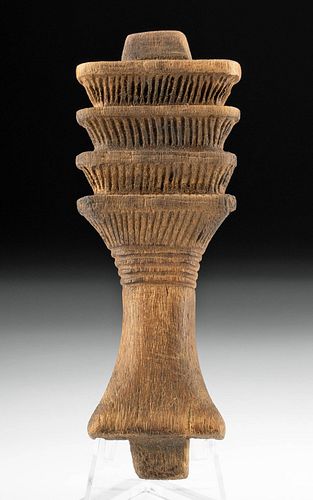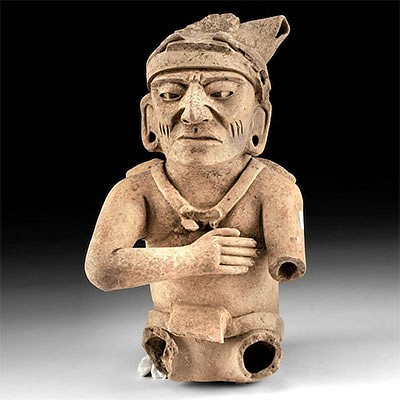Egyptian Carved Wood Amulet Djed Pillar
Lot 5
About Seller
Artemis Fine Arts
686 S Taylor Ave, Ste 106
Louisville, CO 80027
United States
Selling antiquities, ancient and ethnographic art online since 1993, Artemis Gallery specializes in Classical Antiquities (Egyptian, Greek, Roman, Near Eastern), Asian, Pre-Columbian, African / Tribal / Oceanographic art. Our extensive inventory includes pottery, stone, metal, wood, glass and textil...Read more
Estimate:
$400 - $900
Absentee vs Live bid
Two ways to bid:
- Leave a max absentee bid and the platform will bid on your behalf up to your maximum bid during the live auction.
- Bid live during the auction and your bids will be submitted real-time to the auctioneer.
Bid Increments
| Price | Bid Increment |
|---|---|
| $0 | $25 |
| $300 | $50 |
| $1,000 | $100 |
| $2,000 | $250 |
| $5,000 | $500 |
| $10,000 | $1,000 |
| $20,000 | $2,500 |
| $50,000 | $5,000 |
| $100,000 | $10,000 |
| $200,000 | $20,000 |
About Auction
By Artemis Fine Arts
Feb 3, 2022
Set Reminder
2022-02-03 10:00:00
2022-02-03 10:00:00
America/New_York
Bidsquare
Bidsquare : VARIETY SALE | Ancient, Asian, Ethnographic
https://www.bidsquare.com/auctions/artemis-gallery/variety-sale-ancient-asian-ethnographic-8833
Join us for our first sale of February with a spotlight on two fabulous collections, one from Lumberton, Texas, and the other from Whisnant Gallery in New Orleans. Artemis Fine Arts info@artemisgallery.com
Join us for our first sale of February with a spotlight on two fabulous collections, one from Lumberton, Texas, and the other from Whisnant Gallery in New Orleans. Artemis Fine Arts info@artemisgallery.com
- Lot Description
Egypt, Late Dynastic to Ptolemaic Period, ca. 664 to 30 BCE. A hand-carved wooden amulet in the form of a djed pillar, one of the most instantly recognizable symbols from ancient Egypt. The columnar object presents a corseted lower body, a squat tenon protruding from the base of the integral dorsal pillar, and a tiered upper body incised with vertical striations around each level, all wrapped in layers of smooth, coffee brown patina. The djed pillar is highly symbolic of the spine - especially that of Osiris, god of the underworld - and was believed to be the energy conduit necessary for resurrecting the dead. The lower tenon suggests this was perhaps an ornament used for adorning a coffin lid. Lucite display stand for photography purposes only. Size: 1.625" W x 4.6" H (4.1 cm x 11.7 cm)
For an example of a jackal-headed figure, perhaps Anubis, holding a djed pillar, please see The Metropolitan Museum of Art, accession number 10.130.2444
Provenance: private Orange County, California, USA collection, before 2000
All items legal to buy/sell under U.S. Statute covering cultural patrimony Code 2600, CHAPTER 14, and are guaranteed to be as described or your money back.
A Certificate of Authenticity will accompany all winning bids.
PLEASE NOTE: Due to recent increases of shipments being seized by Australian & German customs (even for items with pre-UNESCO provenance), we will no longer ship most antiquities and ancient Chinese art to Australia & Germany. For categories of items that are acceptable to ship to Australia or Germany, please contact us directly or work with your local customs brokerage firm.
Display stands not described as included/custom in the item description are for photography purposes only and will not be included with the item upon shipping.
#122206Minor abrasions to pillar and lower tenon, otherwise intact and very good. Light earthen deposits within some recessed areas and great patina throughout.Condition
- Shipping Info
-
All shipping is handled in-house for your convenience. Your invoice from Artemis Gallery will include shipping calculation instructions. If in doubt, please inquire BEFORE bidding for estimated shipping costs for individual items.
-
- Buyer's Premium



 EUR
EUR CAD
CAD AUD
AUD GBP
GBP MXN
MXN HKD
HKD CNY
CNY MYR
MYR SEK
SEK SGD
SGD CHF
CHF THB
THB













